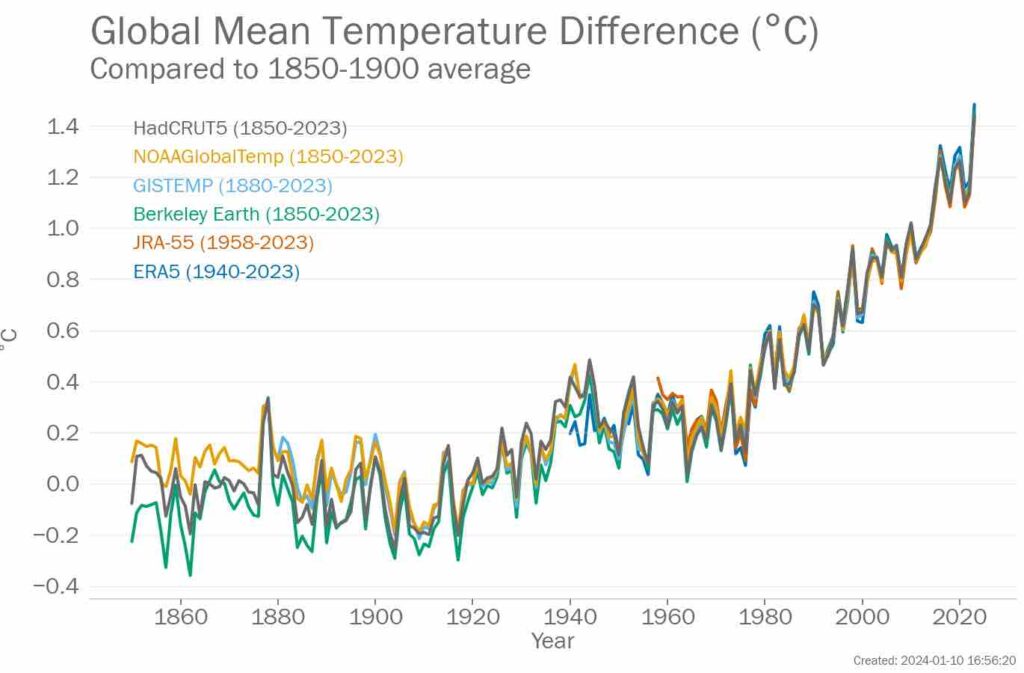The World Meteorological Organization (WMO) has officially confirmed that 2023 is the warmest year on record, by a huge margin.
In an alarming revelation, the World Meteorological Organization (WMO) has confirmed that 2023 has set a new global temperature record, surpassing previous highs by a significant margin. This development brings into sharp focus the escalating challenges of climate change and the urgent need for decisive action.
RELEVANT SUSTAINABLE GOALS



Breaking the Heat Barrier: 2023 in Numbers
The average global temperature in 2023 soared to 1.45 ± 0.12 °C above pre-industrial levels, edging perilously close to the threshold set by the Paris Agreement. This landmark agreement aims to cap temperature increases to 1.5° Celsius above pre-industrial levels, a target that now seems more daunting than ever.
The latter half of 2023 witnessed a unique climatic phenomenon – the merging of El Niño conditions with ongoing climate change. This convergence led to unprecedented heat levels, signaling potential for even higher temperatures in 2024.
A Decade of Warming: The Alarming Trend
Analyzing data from six leading international datasets, the WMO’s findings are incontrovertible. Each decade since the 1980s has been progressively warmer, with the last nine years being the hottest on record. This trend underscores the relentless pace of global warming, driven primarily by human activities.
The record heat of 2023 was not just a climatic event; it had profound socioeconomic repercussions. These ranged from health impacts and agricultural disruptions to exacerbated poverty and environmental degradation.
Prof. Celeste Saulo, WMO Secretary-General, emphasized the gravity of the situation, stating, “Climate change is the biggest challenge humanity faces. It is affecting all of us, especially the most vulnerable.” Echoing her sentiments, UN Secretary-General António Guterres implored for immediate, ambitious action to avert a climate catastrophe.
The WMO’s provisional State of the Global Climate in 2023 report highlights that rising temperatures are just one aspect of a broader crisis. From increased ocean heat and acidification to declining sea ice and glacier mass, the impacts are widespread and escalating.
The Road Ahead: Data-Driven Action
The WMO’s final State of the Global Climate 2023 report, due in March 2024, is expected to provide further insights into the socioeconomic impacts of these climatic changes. The reliance on comprehensive datasets from top meteorological organizations underscores the rigor and precision guiding global climate monitoring and policy responses.
The Paris Agreement remains the cornerstone of international efforts to combat climate change. The recent findings serve as a stark reminder of the urgency to meet its goals. As the world grapples with the possibility of exceeding the 1.5°C increase limit, the need for collective, decisive action has never been more critical.
As the world stands at a climatic crossroads, the choices we make today will determine the future of our planet. It is imperative that nations, corporations, and individuals collectively strive for drastic reductions in greenhouse gas emissions and accelerate the transition to renewable energy sources.
In the face of overwhelming evidence, the path forward is clear. We must rise to the challenge, embracing innovation and collaboration to tackle this existential threat. As Prof. Saulo and Secretary-General Guterres emphasized, the time for debate has passed; what’s needed now is path-breaking action.
Lead image courtesy of Ed Hawkins Warming Stripes.
You may also be interested in :
El Niño Set To Last in 2024 : Climate Disruption and Rising Temperatures




